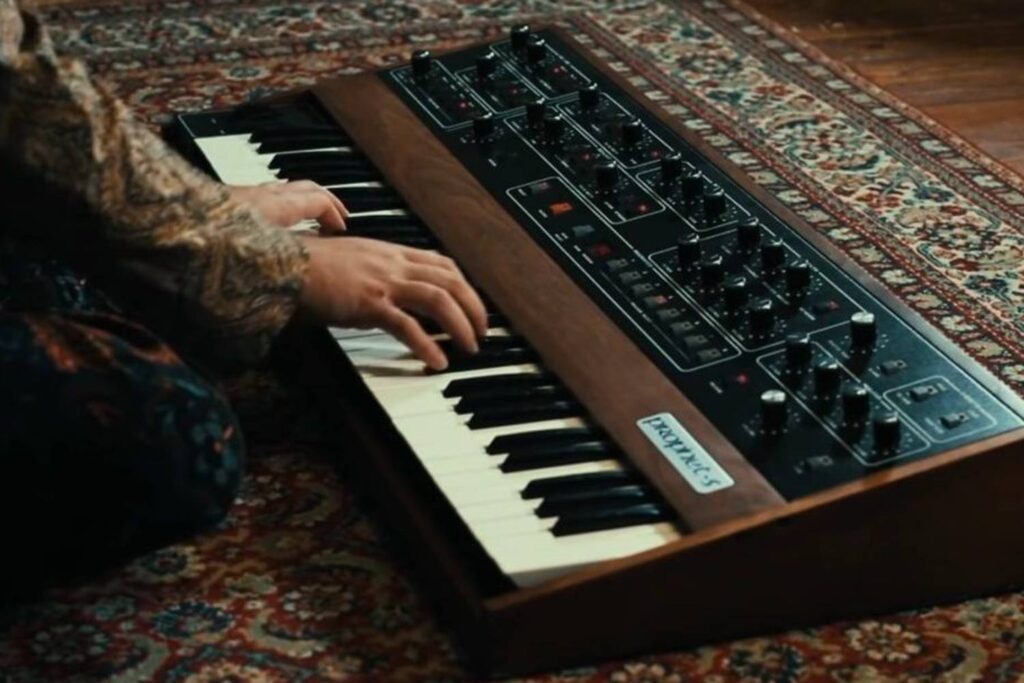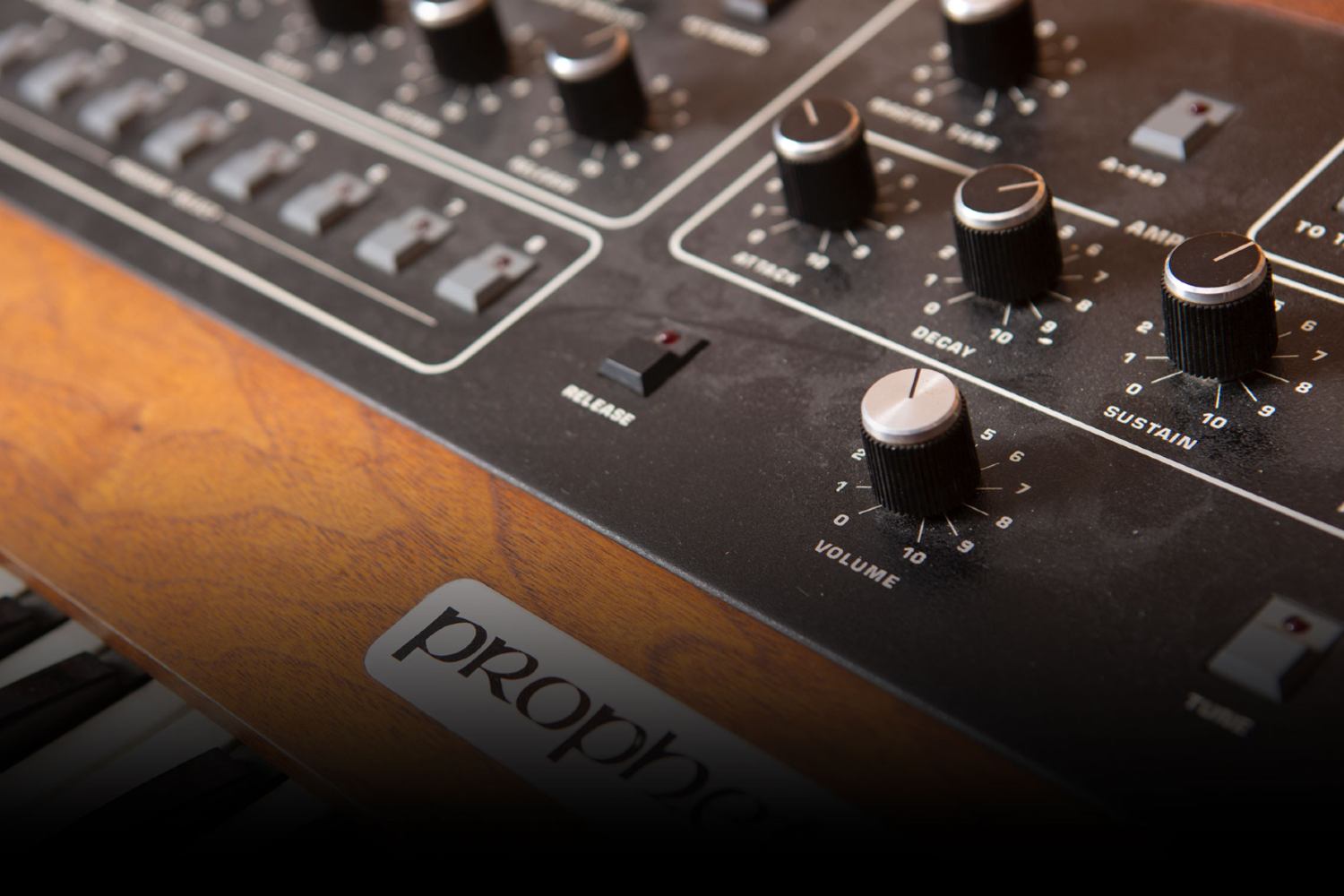The legendary analog synthesizer that shaped music.
In the ever-evolving landscape of music, certain instruments become more than just tools; they become icons that etch their mark on the very fabric of sound. The Prophet-5, an analog synthesizer introduced in the late 1970s by Sequential Circuits, is undeniably one such icon. Throughout its storied history, the Prophet-5 has been a driving force behind a myriad of sonic revolutions, shaping genres, and influencing countless artists.
Unveiled in 1978, the Prophet-5 was a groundbreaking creation which ushered in a new era of sound synthesis. With its innovative use of analog technology and five-voice polyphony, it offered musicians an unprecedented palette of rich, warm, and expressive tones. The Sequential Circuits Prophet-5 quickly captured the imagination of the music world and became the go-to instrument for musicians seeking to explore uncharted sonic territories.

Introduced at a time where fat, warm sounds were celebrated so dearly by artists and music enthusiasts alike, the eighties saw some iconic and notable musicians harness the powerful capabilities of the analog synth to create some of the most memorable and highly celebrated songs of the era.
Read all the latest features, columns and more here.
Gary Numan, the “Cars” hitmaker, found his distinctive voice through the Prophet-5, whilst Nick Rhodes of Duran Duran embraced the synthesizer’s futuristic sound, defining an era of new wave and pop music. Talking Heads employed it in crafting the timeless “This Must Be the Place (Naive Melody)”, while the members of New Order used it to forge a new path in electronic music, and Andrew Farriss of INXS utilized the Prophet-5’s capabilities to add depth and character to the band’s iconic catalog.
Gary Numan
Famous for his use of synth and electronic sounds, it’s no surprise Gary Numan would appear on a list of great Prophet-5 users. Numan’s pioneering use of the analog synthesizer in his music stands as a testament to the synthesizer’s transformative impact on the new wave and electronic music scene. Numan’s distinctive sound, characterised by its futuristic and coldly atmospheric quality, owes much to his innovative exploration of the Prophet-5’s capabilities. Tracks like “Cars” and “Are ‘Friends’ Electric?” exemplify his mastery of the synthesizer, utilizing its rich analog tones to create haunting, otherworldly melodies.
The Prophet-5 became a hallmark of Numan’s sonic identity, propelling him to the forefront of the electronic music movement in the late ’70s and early ’80s. His bold experimentation with the instrument, both in the studio and on stage, has cemented his status as a pioneer in the genre, leaving an indelible mark on the history of electronic music, and further cementing the Prophet-5 as an iconic instrument in its own right.
Talking Heads – “This Must Be the Place (Naive Melody)”
Originally released in 1983 on the groups’ fifth studio album, Speaking in Tongues, “This Must Be the Place (Naive Melody)” has cemented itself as a timeless classic in the space of new wave and avant garde music. The group employed a grooving bass line, a nuanced “Lead 1 line and a more vocal-like “Lead 2” line all with the help of Sequential Circuits Prophet-5.
The song’s iconic sound was captured by the band as they switched their instruments around, putting them out of their comfort zones to achieve the melody’s childlike eudemonia. In the end, bass player Tina Weymouth ended up on rhythm guitar, guitarist and keyboard player Jerry Harrison played keyboard bass, and David Byrne was stationed behind the Prophet-5, all to deliver one of the most brilliant and captivating songs of the analog synth era.
With the swapping of the instruments sounding frivolous and destructive, it encapsulated the honest and endearing nature of the band, and how the simple use of the Sequential Prophet-5 can be utilised to deliver a track of pure soul and creativity.
New Order – “Blue Monday”
Arguably one of the most famous electronic songs of all time, New Order’s “Blue Monday”, which appears on the group’s fourth studio album, opens with an iconic kick-drum beat marking the start of a famous dance track almost anyone can name.
Its iconic sound and popularity wouldn’t be the same without the use of Sequential’s Prophet-5 in crafting the bass sound that carries the fast-moving timeline of the track.
This iconic track, one of the best-selling 12-inch singles of all time, is a shining example of the Prophet-5’s transformative influence in the realm of electronic music. Bernard Sumner’s mastery of the synthesizer, combined with Stephen Hague’s production, resulted in a pioneering sound which pushed the boundaries of what was achievable in the early ’80s.
The Prophet-5’s resonant and graceful tones added an unmistakable depth to “Blue Monday,” providing a haunting and evocative backdrop for the band’s signature blend of post-punk and dance elements. The synthesizer’s role in shaping the track, alongside New Order’s distinctive sound, has left an indelible mark on the electronic music landscape, solidifying the Prophet-5’s status as an integral part of the band’s sonic identity and a symbol of innovation in the genre.
INXS – “Don’t Change”
INXS’ “Don’t Change” saw the Aussie home-grown band become internationally recognised as legendary keyboardist Andrew Farris wielded a Prophet-5 on the studio version of the track.
Farriss’ use of the Prophet-5 synthesizer for INXS’ “Don’t Change” played a pivotal role in shaping the song’s distinctive sound. With its lush and evocative analog tones, the Prophet-5 lent an ethereal quality to the track which perfectly complemented the band’s approach to the growing new wave style. The synthesizer’s ability to create rich, warm textures and expressive, melodic lines elevated the song to a new level of sonic sophistication.
As “Don’t Change” became one of INXS’ most enduring hits, the Prophet-5’s contribution stood as a testament to the synthesizer’s versatility and its power to enhance the emotional impact of the music. The combination of Andrew Farriss’ masterful use of the Prophet-5 and the band’s infectious energy resulted in a timeless classic that continues to captivate audiences today.
Duran Duran
Described by Duran Duran keyboardist Nick Rhodes as a synth he “couldn’t live without”, the Prophet-5 served the founding-member of the English new wave band extremely well in crafting some of their most iconic tracks.
Nick Rhodes’ innovative use of the Prophet-5 synthesizer with Duran Duran added to an already defining time in the history of new wave and pop music. His mastery of this iconic instrument allowed him to craft the band’s signature futuristic sound, characterized by rich, textured layers and ethereal melodies.
The Prophet-5’s warm analog tones provided the perfect sonic palette for Duran Duran’s stylish and otherworldly image, which contributed significantly to their rise to fame. In tracks like “Hungry Like the Wolf” and “Rio”, Rhodes showcased the Prophet-5’s versatility, creating lush, atmospheric soundscapes that seamlessly blended with the band’s catchy hooks and lyrics. As a key architect of Duran Duran’s sound, Rhodes’ pioneering use of the Prophet-5 helped define an entire era of music and continues to influence artists across genres to this day.
Together, these musicians exemplify the Prophet-5’s enduring legacy, showcasing its versatility and creative potential across diverse genres, helping to define an era of music which will forever stand the test of time. Each artist’s journey with the synthesizer serves as a testament to the Prophet-5’s enduring influence on music, as well as its ability to adapt and evolve with the ever-changing musical landscape.

